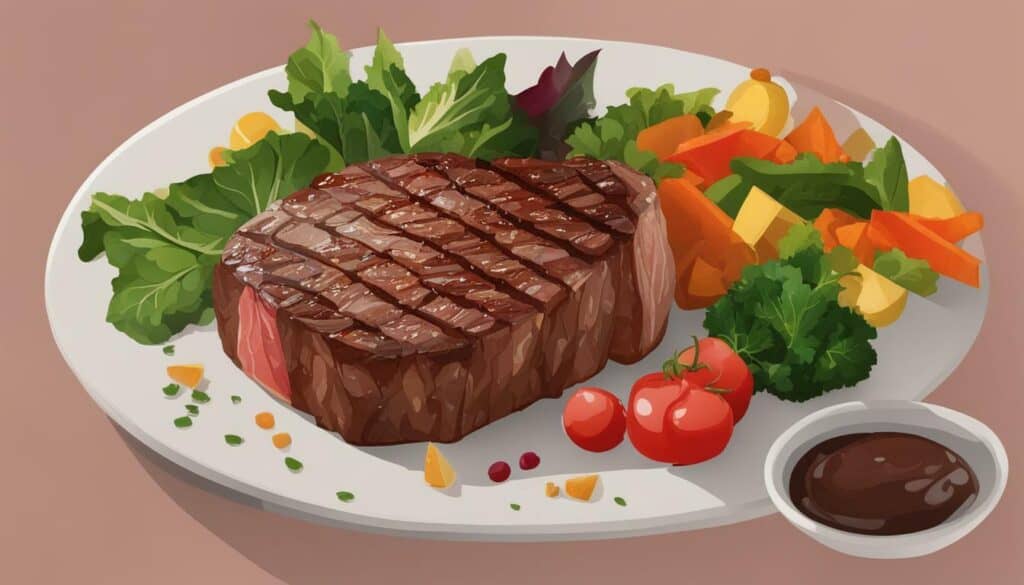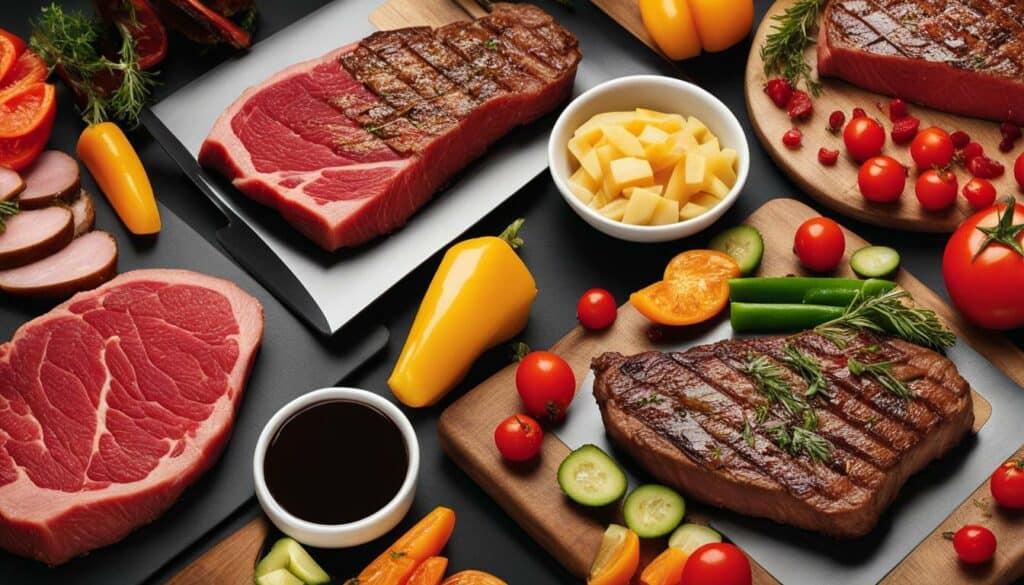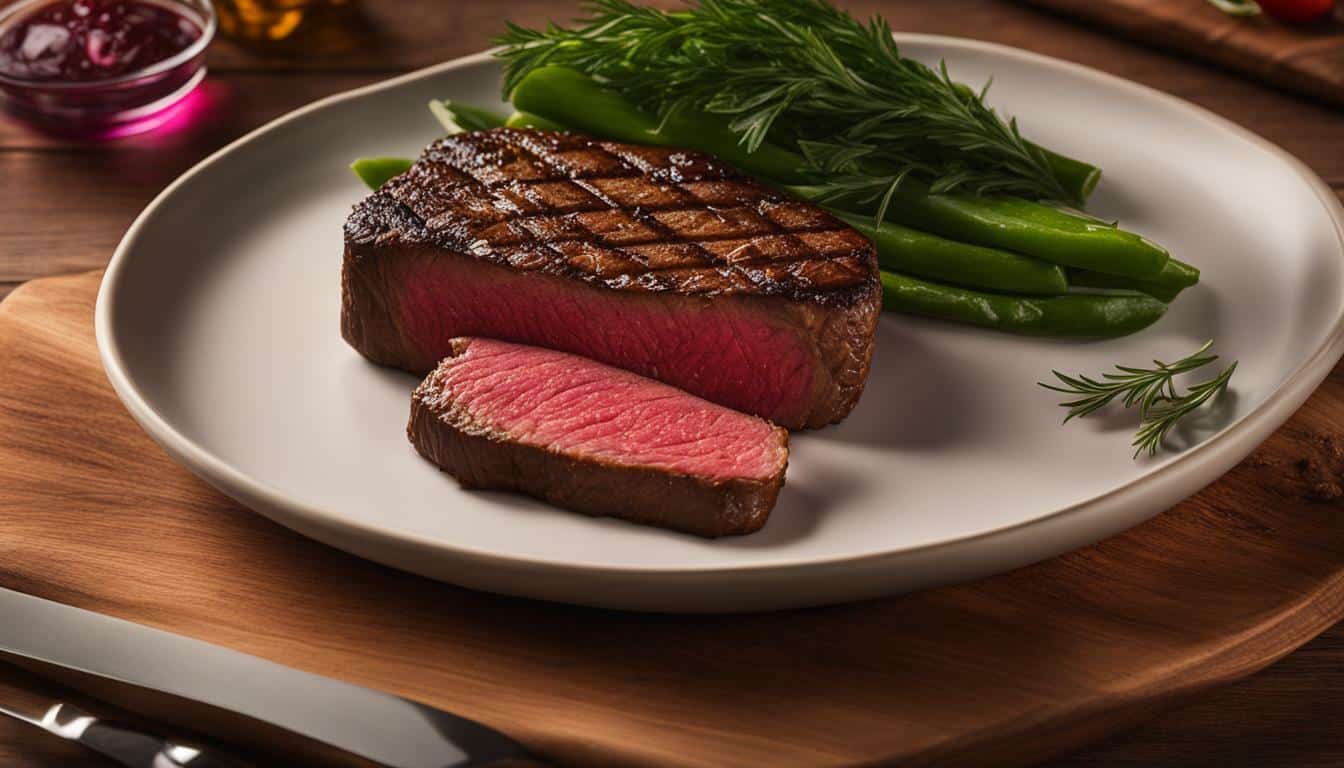Are you curious about the calorie content of a 3 oz steak? Let’s explore the nutritional value of this popular meat and how it can fit into a healthy diet.
When it comes to steak, it is important to understand its nutritional value and how it can fit into a healthy diet. The calorie count and fat content of steak can vary depending on the cut and preparation method. A standard serving size of cooked steak is 3 ounces, which is roughly the size of your phone or palm. A 3-ounce serving of cooked steak contains approximately 160 calories. The fat content of steak is not excessively high, especially if the steak is trimmed of excess fat. On average, a serving of steak contains around 8 grams of fat. Steak is also a great source of protein, with about 24 grams per serving. Additionally, steak is rich in essential vitamins and minerals such as vitamin B12, iron, zinc, and phosphorus.
While steak can be a healthy addition to your diet, it is important to consume it in moderation and pair it with a balanced mix of vegetables and fruits. It is also important to consider individual dietary needs and preferences when incorporating steak into meals. Overall, enjoying steak as part of a balanced diet can provide essential nutrients, support muscle growth, and contribute to overall well-being.
- A 3-ounce serving of cooked steak contains approximately 160 calories.
- Steak is a good source of protein, with about 24 grams per serving.
- Steak is rich in essential vitamins and minerals such as vitamin B12, iron, zinc, and phosphorus.
- It is important to consume steak in moderation and pair it with a balanced mix of vegetables and fruits.
- Consider individual dietary needs and preferences when incorporating steak into meals.
Understanding Steak Serving Sizes and Portions
Before diving into the calorie count, it’s important to understand the recommended serving size for cooked steak and how it relates to your nutrition goals. A standard serving size of cooked steak is 3 ounces, which is approximately the size of your phone or palm. This serving size allows you to enjoy the flavors and nutrients of steak while still maintaining a balanced diet.
When it comes to portion control, it’s helpful to visualize what 3 ounces looks like. Imagine a deck of cards or a bar of soap – that’s roughly the size of a 3-ounce serving of cooked steak. Keeping portion sizes in mind can help you moderate your calorie intake and ensure you’re getting a variety of nutrients from other food groups as well.
It’s also worth noting that the calorie count and fat content can vary depending on the cut of steak and how it’s prepared. Choosing lean cuts of steak and trimming off excess fat can help reduce the overall fat content. This way, you can enjoy the deliciousness of steak while keeping your calories and fat intake in check.
| Nutrient | Amount per Serving |
|---|---|
| Calories | 160 |
| Fat | 8g |
| Protein | 24g |
Steak is not only a great source of protein but also contains essential vitamins and minerals that are important for overall well-being. It is rich in vitamin B12, iron, zinc, and phosphorus. Incorporating steak into your diet can provide these essential nutrients and support muscle growth and repair.
Remember, moderation is key. While steak can be a healthy addition to your diet, it’s important to enjoy it in moderation and pair it with a balanced mix of vegetables and fruits. This combination ensures that you’re getting a wide range of nutrients to support your health and well-being. Additionally, considering your individual dietary needs and preferences is crucial when incorporating steak into your meals.
Summary:
- A standard serving size of cooked steak is 3 ounces, which is roughly the size of your phone or palm.
- Choosing lean cuts of steak and trimming off excess fat can help reduce the overall fat content.
- A 3-ounce serving of cooked steak contains approximately 160 calories, 8 grams of fat, and 24 grams of protein.
- Steak is a rich source of essential vitamins and minerals such as vitamin B12, iron, zinc, and phosphorus.
- Enjoying steak as part of a balanced diet, in moderation, can provide essential nutrients, support muscle growth, and contribute to overall well-being.

A 3-ounce serving of cooked steak contains approximately 160 calories, making it a moderate calorie option for your meals. This serving size is roughly equivalent to the size of your phone or palm, providing a satisfying portion that can fit into a well-balanced diet.
When enjoying a 3-ounce steak, it is important to consider the cut and preparation method, as these factors can affect the overall calorie count. Leaner cuts, such as sirloin or fillet, tend to have fewer calories compared to fattier cuts. Additionally, grilling or broiling the steak without excessive added fats or oils can help keep the calorie content in check.
To give you a better idea of the nutritional breakdown, here’s a table showcasing the calorie content of popular cuts of cooked steak:
| Cut | Calories per 3 oz serving |
|---|---|
| Sirloin | 160 |
| Fillet | 185 |
| Ribeye | 210 |
| T-bone | 240 |
It’s worth noting that these figures are approximate and can vary. The cooking method, seasoning, and any added sauces or toppings can impact the overall calorie count. To ensure accuracy, always refer to specific nutrition labels or consult a registered dietitian for personalized guidance.
Remember, moderation is key when incorporating steak into your diet. While it can be a flavorful and nutritious protein source, it’s important to balance it with a variety of vegetables and fruits to create a well-rounded meal. By doing so, you’ll not only enjoy the benefits of steak’s essential nutrients like vitamin B12, iron, zinc, and phosphorus, but also promote a healthy lifestyle overall.

Managing Fat Content in Steak
While steak does contain fat, it is not excessively high, especially if you opt for lean cuts and trim off any visible fat. Choosing lean cuts of steak, such as sirloin or tenderloin, can help reduce the overall fat content. Remember to remove any excess fat before cooking to further decrease the fat content.
In a 3-ounce serving of cooked steak, you can expect to find around 8 grams of fat. This moderate amount of fat can contribute to the flavor and juiciness of the steak, but it is important to be mindful of portion sizes to ensure a balanced intake. Pairing your steak with a variety of vegetables and fruits can help create a well-rounded meal while adding essential nutrients and fiber to your diet.
When it comes to steak preparation, opting for grilling, broiling, or roasting methods can help melt away some of the fat naturally, allowing it to drip off during cooking. This can be a healthier choice compared to frying or breading the steak, which can add additional fat and calories.
Table: Fat Content in Different Cuts of Steak
| Steak Cut | Grams of Fat per 3-ounce Serving |
|---|---|
| Sirloin | 5 grams |
| Tenderloin | 4 grams |
| Ribeye | 12 grams |
| T-bone | 11 grams |
| New York Strip | 10 grams |
By making conscious choices when selecting and preparing your steak, you can enjoy this delicious protein source while managing your fat intake. Remember, moderation is key, and incorporating a variety of nutrient-rich foods alongside your steak can help support a well-balanced and healthy diet.

Steak is a great source of protein, with approximately 24 grams per 3 oz serving, which can support muscle growth and repair. Protein is an essential macronutrient that plays a vital role in building and maintaining muscle mass. Whether you’re an athlete looking to optimize performance or simply aiming to lead a healthy lifestyle, incorporating protein-rich foods like steak into your diet can be beneficial.
Protein is made up of amino acids, which are the building blocks of our body’s tissues. When we consume protein, it gets broken down into these amino acids, which then help repair and build new muscle fibers. This is particularly important for individuals who engage in regular physical activity, as the muscle fibers undergo stress and damage during exercise.
In addition to its muscle-building properties, protein also has other important roles in the body. It aids in the production of enzymes, hormones, and antibodies, and helps regulate various bodily functions. Protein can also help keep you feeling full and satisfied, which can be beneficial for weight management.
“Protein is an essential macronutrient that plays a vital role in building and maintaining muscle mass.”
When it comes to choosing the right type of steak for protein intake, opt for lean cuts such as sirloin, tenderloin, or eye of round. These cuts tend to have less fat content while still providing ample protein. It’s also important to note that the cooking method can affect the nutrient content of the steak. Grilling or broiling steak is a healthier option compared to frying or pan-searing, as it allows excess fat to drip away.
Including steak in your meals can not only contribute to your protein intake but also provide essential vitamins and minerals. Steak is rich in iron, which is crucial for transporting oxygen throughout the body, as well as vitamin B12, which supports brain function and the production of red blood cells. Additionally, steak contains zinc, which plays a role in immune function, and phosphorus, which is important for bone health.

| Nutrient | Amount per 3 oz serving |
|---|---|
| Protein | 24 grams |
| Iron | 2.5 mg |
| Vitamin B12 | 1.3 mcg |
| Zinc | 3.8 mg |
| Phosphorus | 180 mg |
Essential Nutrients in Steak
In addition to protein, steak is rich in essential nutrients like vitamin B12, iron, zinc, and phosphorus, which are important for overall health and well-being. Vitamin B12 is essential for the production of red blood cells and the functioning of the nervous system. Iron is crucial for transporting oxygen throughout the body and supporting energy production. Zinc plays a role in immune function, cell division, and wound healing. Phosphorus is necessary for bone health and the formation of DNA.
Including steak in your diet can help ensure you’re getting these vital nutrients. The table below provides an overview of the nutritional content of a 3-ounce serving of cooked steak:
| Nutrient | Amount per Serving |
|---|---|
| Protein | 24 grams |
| Vitamin B12 | 2.7 micrograms |
| Iron | 2.4 milligrams |
| Zinc | 3.5 milligrams |
| Phosphorus | 190 milligrams |
As you can see, a 3-ounce serving of steak provides a substantial amount of protein along with significant doses of these essential nutrients. Incorporating steak into your diet can help support muscle growth, maintain energy levels, and contribute to overall well-being.
Remember to choose lean cuts of steak and trim excess fat to minimize calorie and fat intake. Additionally, it’s important to consume steak in moderation as part of a balanced diet that includes a variety of vegetables, fruits, whole grains, and other nutrient-rich foods.

While steak can be a nutritious addition to your meals, it is crucial to consume it in moderation to balance your calorie and nutrient intake. Being mindful of portion sizes and frequency of consumption can help you reap the benefits of steak without overindulging.
A 3-ounce serving of cooked steak contains approximately 160 calories, making it a relatively calorie-dense food. By being aware of your overall daily calorie needs, you can allocate a reasonable portion of your calorie intake to enjoy a steak without exceeding your energy requirements.
In addition to calorie content, it is important to consider the fat content in steak. On average, a serving of steak contains around 8 grams of fat. By choosing leaner cuts of steak and trimming excess fat, you can reduce the overall fat content and make it a healthier choice. Additionally, incorporating a variety of vegetables and fruits alongside your steak can help provide fiber, vitamins, and minerals, creating a more balanced and nutritious meal.

Steak is not only a good source of protein but also contains essential nutrients like vitamin B12, iron, zinc, and phosphorus. These nutrients are important for various bodily functions, including red blood cell production, metabolism, and immune function. Including steak in your diet can help ensure you are meeting your nutrient needs.
Remember, everyone’s dietary needs and preferences are unique. If you are following a specific diet or have any health concerns, it’s always a good idea to consult with a healthcare professional or registered dietitian to determine the best way to incorporate steak into your meals. With moderation and a balanced approach, steak can be a delicious and nutritious addition to a healthy lifestyle.
| Calories in a 3 oz Steak | Fat Content in a 3 oz Steak | Protein in a 3 oz Steak |
|---|---|---|
| Approximately 160 calories | Around 8 grams of fat | About 24 grams of protein |
Pairing Steak with a Balanced Diet
To maximize the nutritional benefits of steak, pair it with a variety of colorful vegetables and fruits to create a well-balanced and satisfying meal. Vegetables and fruits are rich in vitamins, minerals, and fiber, which complement the protein and nutrients found in steak. Including a variety of vegetables in different colors, such as leafy greens, peppers, and tomatoes, ensures a diverse range of nutrients that support optimal health.
One delicious way to incorporate vegetables with steak is by grilling skewers of bell peppers, onions, and cherry tomatoes alongside your steak. The natural sweetness and crunch of these vegetables complement the savory flavors of the steak, providing a satisfying and well-rounded meal. Alternatively, you can serve a side salad consisting of mixed greens, cucumbers, and avocados, topped with thinly sliced strips of grilled steak for a refreshing and nutritious option.
When it comes to pairing steak with fruits, consider adding a burst of sweetness and brightness by incorporating seasonal fruits like berries, citrus fruits, or melons. These fruits not only provide vital antioxidants but also add a refreshing element to your meal. You can create a simple fruit salsa using diced mangoes, strawberries, and a squeeze of lime juice to complement a perfectly grilled steak. The combination of juicy fruits and tender steak creates a delightful contrast of flavors and textures.

| Steak Cut | Calories | Fat (g) | Protein (g) |
|---|---|---|---|
| Sirloin | 160 | 8 | 24 |
| Ribeye | 190 | 11 | 22 |
| Filet Mignon | 200 | 10 | 27 |
Table: Nutritional information for different cuts of steak.
Remember, the key to a healthy and fulfilling diet is balance. While steak can provide essential nutrients and protein, it should be enjoyed in moderation as part of a well-rounded eating plan. By combining steak with a colorful array of vegetables and fruits, you can create a satisfying and nutritious meal that supports your overall health and well-being.
Considering Individual Dietary Needs
It’s important to take into account your specific dietary needs and preferences when deciding how often and in what portion size you include steak in your diet. While steak can be a nutritious choice, it’s essential to consider factors such as calorie intake, protein requirements, and overall balance in your meals.
When it comes to calories, a 3-ounce serving of cooked steak contains approximately 160 calories. This information can be valuable for those who are monitoring their calorie intake or following a specific meal plan. If you’re aiming for weight loss or weight maintenance, it’s crucial to be mindful of the portion size and how it fits into your overall daily calorie goals.
Additionally, protein is an essential nutrient that plays a crucial role in muscle growth and repair. A 3-ounce serving of steak provides about 24 grams of protein, making it a valuable option for individuals looking to meet their protein needs. However, it’s important to consider other protein sources in your diet as well, such as legumes, poultry, fish, and plant-based alternatives.
Lastly, personal preferences and dietary restrictions should also be taken into account when incorporating steak into your meals. Some individuals may have specific health conditions or dietary preferences that require them to limit their intake of certain nutrients or choose specific cuts of steak that align with their dietary needs. Consulting with a healthcare professional or registered dietitian can be beneficial in navigating these considerations and ensuring a well-rounded dietary plan that meets individual needs.
Table: Macronutrient Content of a 3 oz Steak
| Nutrient | Amount per 3 oz serving |
|---|---|
| Calories | 160 |
| Protein | 24g |
| Fat | 8g |
Understanding the nutritional content of steak and considering your individual needs can help you make informed choices about how to incorporate it into your diet. By being mindful of portion sizes, balancing with other nutrient-rich foods, and taking into consideration your specific dietary requirements, you can enjoy the benefits of steak as part of a healthy and balanced eating plan.

When consumed as part of a balanced diet, steak can provide essential nutrients, support muscle growth, and contribute to your overall well-being. Steak is not only a delicious option for meat lovers, but it also offers a range of nutritional benefits. Let’s take a closer look at why incorporating steak into your diet can be a healthy choice.
Firstly, steak is an excellent source of high-quality protein. A single 3-ounce serving of cooked steak contains around 24 grams of protein. Protein is essential for repairing and building tissues, supporting muscle growth, and maintaining a healthy immune system. Including steak in your diet can help meet your daily protein needs and support your active lifestyle.
In addition to protein, steak is also rich in essential vitamins and minerals. It is a particularly good source of vitamin B12, iron, zinc, and phosphorus. Vitamin B12 is important for brain function and the production of red blood cells, while iron is crucial for oxygen transport in the body. Zinc and phosphorus play key roles in immune function and bone health. By enjoying steak, you can boost your intake of these important nutrients.
It is worth noting that not all cuts of steak are equal when it comes to nutrition. Choosing lean cuts, such as sirloin or tenderloin, can help reduce your intake of saturated fats. These cuts typically have lower fat content while still providing ample amounts of protein and essential nutrients. Incorporating lean steak into your balanced diet can be a great way to enjoy the benefits of this flavorful meat while keeping your saturated fat intake in check.
| Nutrient | Amount per 3 oz serving |
|---|---|
| Protein | 24g |
| Vitamin B12 | 1.2mcg |
| Iron | 2.8mg |
| Zinc | 4.5mg |
| Phosphorus | 190mg |
Overall, steak can be a valuable addition to a balanced diet due to its protein content and rich nutrient profile. By choosing lean cuts and balancing it with a variety of fruits and vegetables, you can enjoy the benefits of steak without compromising your health. Remember, moderation is key, so be mindful of portion sizes and listen to your body’s needs. Enjoying a delicious steak meal can be a satisfying and nutritious part of your overall wellness journey.

Armed with knowledge about the calorie content and nutritional value of steak, you can make informed choices that align with your health and wellness goals. Steak can be a delicious and satisfying addition to your diet, but it’s important to consider portion sizes and preparation methods to ensure you’re getting the most benefit.
When it comes to calories, a 3-ounce serving of cooked steak contains approximately 160 calories. This calorie count can vary depending on the cut and cooking method, so it’s worth checking the nutritional information for the specific type of steak you’re consuming. To keep your steak lower in fat, opt for lean cuts like sirloin or tenderloin, and trim off any visible fat before cooking.
Steak is a great source of protein, providing about 24 grams per serving. This essential nutrient supports muscle growth and repair, making it an excellent choice for active individuals or those looking to build or maintain muscle mass. Additionally, steak is rich in essential vitamins and minerals such as vitamin B12, iron, zinc, and phosphorus, which play vital roles in maintaining overall health and well-being.
To enjoy steak as part of a balanced diet, it’s important to pair it with a variety of vegetables and fruits. These colorful additions provide additional nutrients, fiber, and antioxidants that can further support your health goals. Incorporating different cooking methods, such as grilling or roasting, can also add variety to your meals and enhance the flavor of your steak.

Remember, everyone’s dietary needs and preferences are unique, so it’s essential to consider what works best for you. If you have specific dietary restrictions or preferences, there are plenty of alternative protein sources available that can still provide the nutrients your body needs. By making informed choices and finding the right balance for your lifestyle, you can enjoy steak as part of a healthy and well-rounded diet.
Conclusion
Understanding the calories in a 3 oz steak empowers you to make mindful choices that support your nutrition goals while savoring the deliciousness of this popular meat. When it comes to steak, it’s important to consider the nutritional value and how it can fit into a healthy diet. A standard serving size of cooked steak is 3 ounces, approximately the size of your phone or palm. This portion contains approximately 160 calories, making it a reasonable option for those watching their calorie intake.
The fat content in steak is not excessively high, particularly when trimmed of excess fat. On average, a serving of steak contains around 8 grams of fat. It’s worth noting that not all fats are created equal, and lean cuts of steak can provide a good balance of fats for your diet.
What makes steak particularly beneficial is its protein content, with approximately 24 grams per serving. Protein is essential for muscle growth and repair, making steak a great choice for those leading an active lifestyle or looking to build lean muscle mass. Additionally, steak is a rich source of essential vitamins and minerals, including vitamin B12, iron, zinc, and phosphorus.
While enjoying steak as part of a balanced diet can provide essential nutrients and support overall well-being, it’s important to consume it in moderation. Pairing steak with a variety of vegetables and fruits can enhance its nutritional value and contribute to a well-rounded meal. Always consider your individual dietary needs and preferences when incorporating steak into your meals to ensure it aligns with your overall nutrition goals.
In conclusion, understanding the calorie content and nutritional value of a 3 oz steak allows you to make informed choices and enjoy this delicious meat while staying on track with your health and wellness goals. Incorporate steak into your diet mindfully, and reap the benefits of its protein, vitamins, and minerals along with the satisfaction it brings to your taste buds.
FAQ
Q: What is the serving size of cooked steak?
A: The standard serving size of cooked steak is 3 ounces, which is roughly the size of your phone or palm.
Q: How many calories are in a 3 ounce serving of cooked steak?
A: A 3-ounce serving of cooked steak contains approximately 160 calories.
Q: How much fat is in a serving of steak?
A: On average, a serving of steak contains around 8 grams of fat, especially if the steak is trimmed of excess fat.
Q: What is the protein content of steak?
A: Steak is a great source of protein, with about 24 grams per serving.
Q: Are there any essential vitamins and minerals in steak?
A: Yes, steak is rich in essential vitamins and minerals such as vitamin B12, iron, zinc, and phosphorus.
Q: How should I incorporate steak into my diet?
A: It is important to consume steak in moderation and pair it with a balanced mix of vegetables and fruits.
Q: Can I adjust my steak consumption based on my dietary needs?
A: Yes, it is important to consider your individual dietary needs and preferences when incorporating steak into your meals.
Q: What are the overall benefits of including steak in a balanced diet?
A: Enjoying steak as part of a balanced diet can provide essential nutrients, support muscle growth, and contribute to overall well-being.
How Many Calories are in a 4 oz Portion of Steak?
Curious about the caloric content of a 4 oz portion of steak? Look no further than our handy oz portion guide for steak calories. This size of steak typically ranges between 250-300 calories, depending on the specific cut and cooking method used. Remember to factor in any additional sauces or seasonings that could affect the overall calorie count.





Leave a Reply